Problems and Solutions
International visitors please note: We cannot ship any of the products on this page to you due to postal and customs regulations.
Bonsai trees, like many other plants, need protection from nasty chewing, sucking and biting insects. They also need to be protected from many of the fungi which cause many visually noticeable problems with many living parts of the tree.
I believe the best form of treatment is to ensure the health of the tree; in this way you enable the tree itself to ward off most attacks. A healthy plant will have sufficient water, it will be suitably fed, have good air circulation around the foliage and healthy roots growing in a well drained growing medium.
One of the most common problems today is not understanding the best location for your tree. This has arisen due to retailers often displaying trees under cover or even indoors. Customers then assume the tree should remain indoors when in fact it is not an indoor tree. Make sure from someone who is properly informed (and often this is not the shop assistant) whether it is an indoor or outdoor tree.
Your environment
When I refer to your environment I mean the space or location where you keep your trees. Few bonsai artists that I know of give any consideration to the hygiene or cleanliness of these spaces. This is vastly different to the approach which professional nurseries take of regular disinfection.
It is important to consider and take measures to keep the level of potential sources of fungal and bacterial infections to a minimum. Some of the traditional treatments used for this domestically are not biodegradable and are actually carcinogenic.
However I have been able to source a product which has till recently only been available to the commercial nurseryman and agricultural sector called Sporekill. Sporekill is a product which can be used to disinfect surfaces, containers and even sprayed (at the correct dilution) directly onto plants. I highly recommend that Sporekill be added to your arsenal with which you prevent and eradicate problems from occurring and or compounding in your bonsai growing spaces. Read more about Sporekill here.
Common Pests
The following are the most common pests of interest to bonsai artists, and which you are most likely to encounter.
Ants
Ants on your bonsai can be used as an indication that you most likely also have aphids. This is because ants often carry the eggs of aphids to suitable vegetative growth in order to eventually farm the sugary secretion they produce called "Honeydew." The ants themselves are generally not a problem but if you see them in large numbers around your tree they may have built a nest in the pot, in which case they should be dealt with.
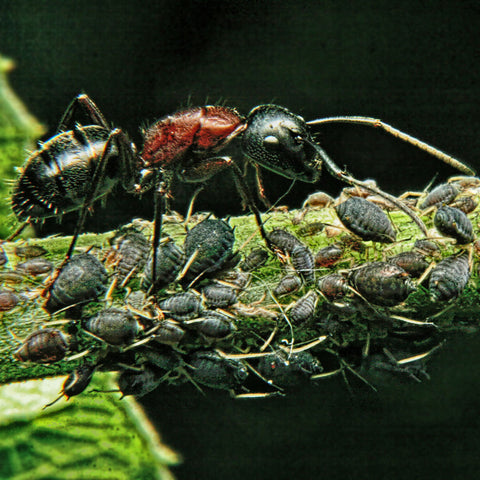
Symptoms
As mentioned already, ants themselves are generally not a problem but they often carry aphid eggs and fungus such as the "black sooty mould." They sometimes will also build nests in your bonsai pots and in the process of doing so will excavate a lot of your growing media.
Treatment
If you do find an ant nest it can be a sign that your trees are not being watered correctly, however in the case of some species such as pines which prefer drier growing conditions, this cannot be altered. Simply dipping the whole pot into a container of water will not permanently solve the problem either. You will need to use a pesticide such as Koinor as a soil drench, and which will prevent many other common pests. You may also use Kemprin or Bungy.
Anthracnose
Anthracnose is actually a broad term referring to a number of different plant diseases which are particularly damaging to trees and is caused by fungus. Anthracnose causing fungus survives on plant material inoculated with it and it spreads both easily and quickly. Proliferating under warm, moist conditions which our daily regime of watering will exacerbate.
Whenever the environmental conditions are right and when new leaves are developing, anthracnose is a risk. Once leaves mature (become leathery) they come resistant. It stands to reason that techniques such as defoliation will increase your risk as well as overhead watering when the weather is warm.
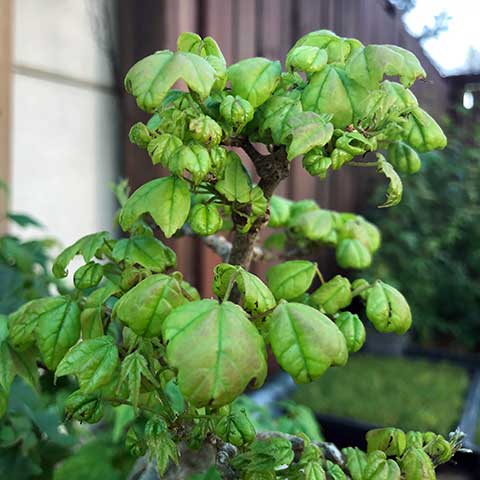
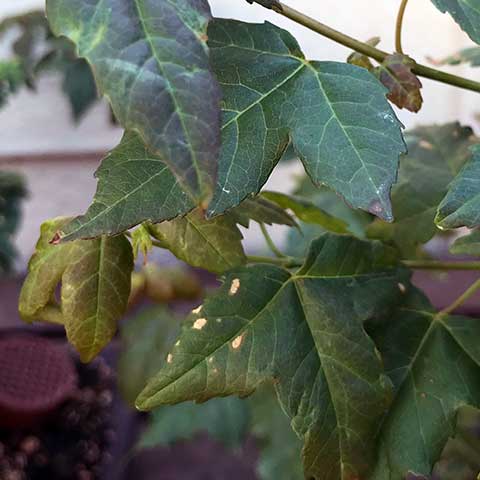
Symptoms
The symptoms of anthracnose are very easy to spot - when you know what to look for. However in my experience most people don't correctly diagnose it and attribute the early signs of anthracnose to leaf scorch or burn, other fungal issues and more. The curling, distorting and leaves which appear completely or partially burnt are easy to spot. As the disease worsens you may notice brown patching and large spots on leaves brown patches may present themselves as spots on the leaf. In my experience only deciduous trees are affected and not evergreens or conifers. So any of the maples are particularly prone but also at risk are privets, pomegranite, firethorns, hackberry (celtis), flowering quince, rock spray and to a lesser degree elms.
Anthracnose is not necessarily going to kill your bonsai tree but if left untreated it will weaken leaving it more prone to other fungal, insect and bacterial attack. This in turn may lead to the death of a branch and ultimately to the demise of the tree. I have knowledge of several rather capable bonsai enthusiasts who have lost trees as a result of this problem.
Treatment
The best advice is to treat as soon as possible to prevent the condition becoming worse and from spreading further to adjacent plants. It may be worthwhile to separate infected plants until you're certain you have the problem under control.
Chemical sprays which contain the following active ingredients have been tested for anthracnose: Mancozeb, Chlorothalonil, Propiconazole, Thiophanate methyl and fungicides containing copper. I recommend repeated treatments of Odeon (containing active ingredient Chlorothaonil) together with SK Eco Oil (as wetting agent and general fungicide). Myself and several others have been experiencing good results with Odeon and Sporekill. Chronos is another product registered for anthracnose as it contains prochloraz.
Aphids
These are one of the most common bonsai tree pests. Aphids suck plant sap from the plant but they can also carry diseases. Aphids are generally green, but you can also find them in grey or black. You will usually find them on new stem growth or the bottom leaves. As these pests can cause considerable damage to your bonsai tree in a short period of time, it's a good idea to look out for them during the active growing periods when doing your watering rounds.
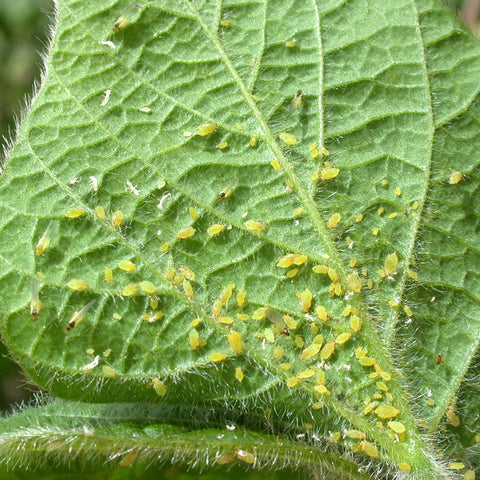
Symptoms
Weak leaves and branches are usually telltale signs of aphid attack. Some new growth may display curling or other deformations. Aphids also produce a sticky, sugary secretion called “honeydew.” Honeydew is enjoyed immensely by ants so you will usually see ants crawling up and down your trees as they harvest the dew. Another growth soon develops as a result of the dew, called “black sooty mould."
Treatment
Wash off affected growth with a jet of water if the population is not too large. You may also rely on the natural enemy of aphids; ladybirds and more specifically their larva, however this might be too late to prevent the weakening of the tree which occurs as a result of these sap sucking pests. Recommended treatments including the systemic insecticide Koinor, if the plant is actively growing, as it has season long action and not only against aphids. The next best all rounder is Plant Care which is broad spectrum being both contact and systemic, and acts for up to 4 weeks so will act quicker than Koinor in this instance as it can also be used as a spray. Seizer and Rose Protector are other suitable broad spectrum insecticides.
Borer
Tree borers consist of many different insects which lay their eggs on or beneath the bark of a tree. When the eggs hatch, the emerging larvae will chew their way in the living tissue or fiber of the tree wreaking havoc.
Symptoms
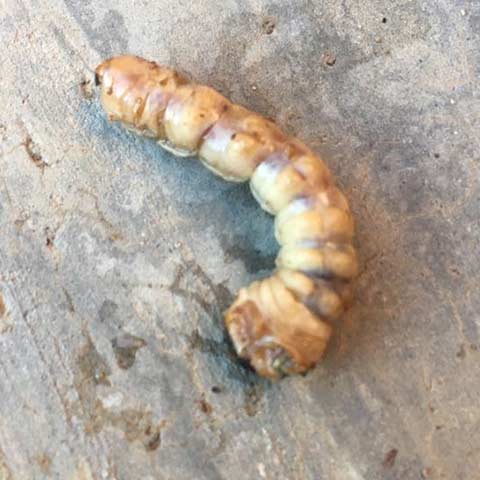
As the larvae chew their way through your tree on their way to adulthood their sometimes ferocious appetites will weaken the tree as the plant tissue they eat is vital for normal functioning of the tree. If undiscovered or untreated the damage done will be such that if you attempt to bend a branch or the trunk it may snap under the pressure.
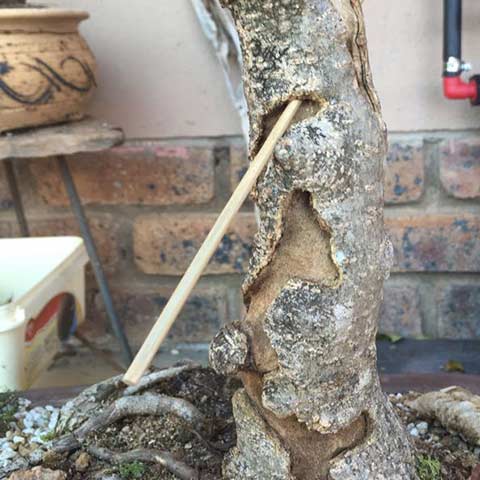
If you don't spot the adult insect on your tree then you will almost certainly see the telltale signs that she was there and that her eggs have hatched; small holes in the bark left by the developing larvae. The holes can be of various shapes and you may also see evidence of some internal excavations by the sawdust laying at the base of the trunk, or in the vicinity.
Treatment
Treating trees where you already have a borer problem can be a real challenge. If the visible evidence of their presence is significant then it is mostly best to destroy (by burning it) the tree as the internal damage will never heal. So unless you can make the damage a feature of the tree, the effort of eradicating the borers and the risk of them attacking neighboring trees is not worth it.
Borers, not unlike most insect pests are apparently more likely to attack or take advantage of weakened trees; especially heavily pruned trees. Its very important to seal these cuts as it is through these open wounds that borers can gain easy initial entry to the tree.
Some chemical treatments may have an effect on trees with a light infestation, however once a tree is infected systemic treatment will be of little to no effect. A tree adequately treated with a systemic pesticide such as Koinor or Plant Care should prevent borers as insects which feed on such trees should be killed. However if you missed preventing the adult female from laying eggs and there are already borers active inside the tree then you can either try to kill the larvae by repeatedly inserting and removing a piece of wire. Alternatively you can use Plant Care in a syringe and squirt it into the tunnels as it is not only systemic but contact as well (It is its contact ability which is of use now).
Caterpillars
These are generally the larval stage of butterflies or moths. Most damage is done above ground, to the leaves which can rapidly be stripped to the stem. Some of the fig bonsai are particularly prone to a seasonal, small black caterpillar which eats their leaves. It is important that as soon as you see caterpillar damage to address the issue and remove the offending pest before they do further damage.
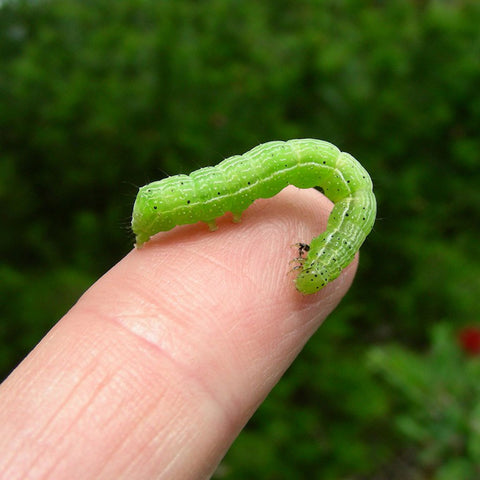
Symptoms
The damage left by caterpillars is usually very easily noticed in the form of chewed leaves.
Treatment
Sometimes the most effective treatment is simply to remove them by hand, if you can find them, as they are often well camouflaged. Look under leaves, underneath branches and on the underside of the trunk. Sometimes you will even find them retreating from the daylight by hiding underneath the pot. I find that if I use a long lasting systemic insecticide such as Plant Care I can control not only caterpillars throughout the growing season, but many other problem pests as well. Or you may also use Seizer.
Mealy Bugs
Mealy bugs are easily identifiable as small white furry insects. This white "cotton ball" is actually a waxy covering which mealy bugs use to protect themselves. They are normally found in groups, apart from the Australian bug which usually is found as an individual. (There may well be multiple Australian bugs on a single tree however) Mealy bugs are usually found on the underside of branches or in the cover of groups of leaves. Another type of mealy bug inhabits the root zone of your bonsai tree. When re-potting, it is a good idea to check the roots for these insects.
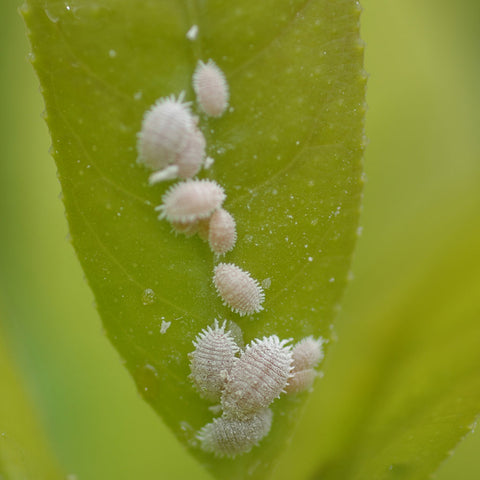
Symptoms
Your tree's growth will be stunted as these pests suck sap. Leaves might show signs of drooping and if the infestation is bad enough the leaves will actually turn yellow and die. Mealy bugs can also cause the development of black sooty mold.
Treatment
During dormant growth periods (Winter) Lime Sulphur is an excellent treatment for not only scale but many other pests and fungi. During active growing periods Koinor, Plant Care or Seizer are the best treatments.
Fungus
Some fungi can be detected by a white mold which can be found on the foliage. Others leave orange or brown patches or even blisters spreading over the underside of the leaves, which curl up and eventually drop. Other still will attack your roots in favourable conditions and can kill a tree. The following are the most commonly found fungi and how to identify them.
Species and Symptoms
Black Spot
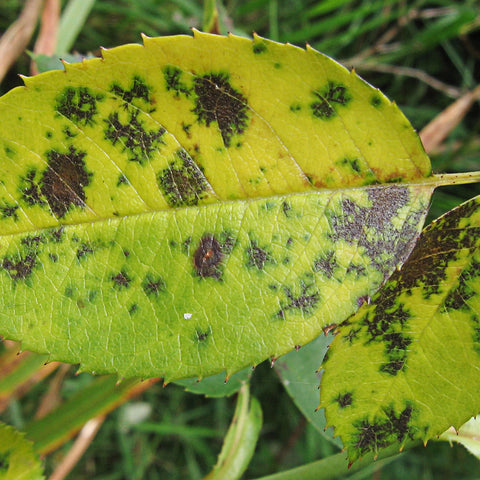
Black Spot is a common fungus which attacks foliage and manifests as black spots or patches on the leaf. Affected leaves will not recover and will need to be removed from the tree. Watering infected foliage will result in this fungus spreading even further. Treatments include Odeon, Chronos, Orius or Rose Protector.
Leaf Spot

Leaf Spot is very often confused with Black Spot. Evidence of infection are white, black, brown, or grey spots on leaves, but woody growth such as twigs and branches may also be affected. Once again infected growth should be removed as soon as possible and an appropriate treatment applied to the tree. Treatments include Odeon.
Mildew

Mildew is a type of fungi which is prevalent in consistently damp conditions, receiving little sunlight and in areas of poor ventilation (So bonsai positioned indoors are particularly prone). White "fluffy" growth in the case of Powdery Mildew, or a unsightly black substance in the case of Sooty mould can be seen on the affected areas. Treatments include Odeon.
Needle Cast

Needle Cast is a fungal issue which can easily develop on spring needles in Pines and once infection is present there is of course little you can do and the evidence will take several seasons to disappear. What to look out for:
- Uneven browning of needles
- Banding in green, yellow and red
The best treatment is to treat preventatively in spring when spring needles are emerging. (Needle Cast should not be confused with overwatering symptoms which displays similarly although the browning of the needles is even and there is no banding).
Treatments include Odeon.
Rust
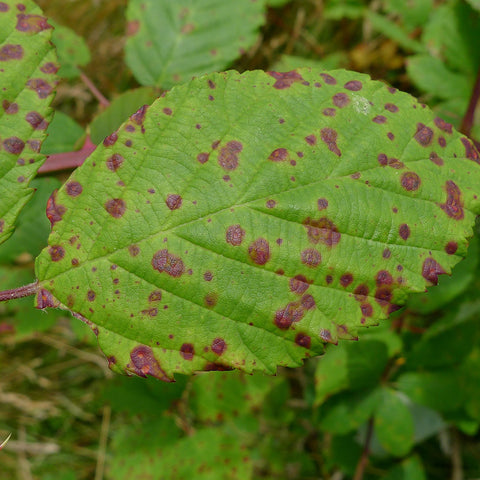
Another common fungal disease which you may encounter can appear as yellow, orange, red, or brown distortions on leaves. These leaves may ultimately curl up, die and fall off. Treatments include Odeon, Orius and Rose Protector.
Root Rot
This fungus, called "phytophthora" grows in your bonsai tree root zone and is a result of poor drainage. It causes roots to turn brown and mushy, and of course die. You will generally be able to determine root rot through a combination of factors such as leaves which become discolored, weak branches which break easily, an overall weak tree together and water which takes some time to drain from your bonsai pot.
Do not confuse root rot with the white, beneficial mycorrhizal fungi which can be found in the growing media of healthy pines, shown in the image below.

Treatment
It is always a good idea to remove any affected foliage you can find on your tree, and certainly those leaves which may have fallen onto the pot or on your benches. Make sure to place your tree in an area with sufficient sunlight and ventilation. In the case of root rot, affected roots must be pruned away and the bonsai transplanted into new, fast draining soil (I would recommend something like pure Pumice or pure, sifted Groperl). As this re-potting might be out of season the tree will be greatly stressed so all feeding should be halted until signs of new, healthy foliage is observed.
Treatments include Lime sulfur which has for a very long time been the fungicide of choice. Not only is it a broad spectrum fungicide, it also prevents the overwintering of many common pests such as aphids, scale and mites. However it can only be used during dormant periods, or damage to your foliage will result (on deciduous trees). Use Orius and/or Odeon as they are both broad spectrum fungicides. Orius is systemic and so will last longer. Odeon is a contact treatment so if washed off there will be no further protection. Alternatives which can be used year round are Rose Protector.
Red Spider Mites
This is one of the most common of the mites that attack bonsai and is also of the most dangerous pests you are likely to encounter as once they have settled on a tree, they can quickly kill it.
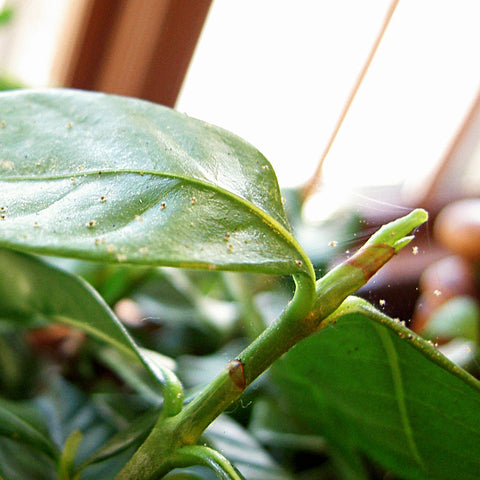
Symptoms
Evidence of their attack is browning growth, leaves with yellow or brown markings. Very fine webs are also evidence of red spider mite. Evergreens such as junipers and pines are generally the first to be attacked by this pest. As mites are really tiny, they are usually not visible with the naked eye on the tree. If you suspect a tree is infected, gently tap a branch over a piece of white paper. If dots which appear on the page move then you have a case of mites.
Treatment
You may use SK Eco Oil, Seizer, Lime Sulphur (dormancy spray only) or Koinor. Plant Care may also be used as a systemic and contact spray for longer term results. (I myself use a combination of SK Eco Oil together with Plant Care on a 4 weekly schedule)
Scale
Scale pests come in a range of colours, from transparent through white, yellow, brown to black. When they are young they move around the tree but eventually fix onto one part where they suck the sap. They often appear like bumps on the trunk, branches or leaves. You will generally not find only one scale insect on a tree, normally there are many of them clustered together, but they may also be found spaced apart. Sometimes its easy to miss them as they adhere to the underside of vegetative material. You will often find ants and sooty mould on trees infected with scale too.

Symptoms
Branches will show signs of drooping and foliage will sometimes wilt, turning a yellow colour. Generally the tree will show signs of weakness.
Treatment
The best solution is to remove small numbers of scale insects by hand before their numbers proliferate. You can try using an insecticide, but this is not always effective due to the protective shell. For small outbreaks, painting the shells with alcohol or surgical spirits works. Many different pesticides available will combat scale insects including Koinor and SK Eco Oil. The latter is a fabulous, affordable product as it is a paraffinic oil so it coats and thus smothers the insect. However it is also a fungicide and wetting agent so can be added to most other treatments.
Slugs and Snails
These pests like damp conditions so they are most common during the rainy season, however they can be found throughout the year. They can easily strip an entire bonsai in a single night, the time when they are most active. New Celtis or Chinese Hackberry leaves are very prone to attack from these pests, but the leaves of many other bonsai species are irresistible to slugs and snails too.

Treatment
Several different organic and chemical based pellet or granule baits are available on the market such as Ferramol. You may also wish to become a nocturnal predator yourself and go outside armed with a torch and a bucket of hot water and collect the snails you can find killing them by throwing them into the water.
White Grubs
Root systems of bonsai trees are attacked by the white, darn ugly looking larvae of many beetles and often the evidence of attack will only be visible long after the larva have brought the tree to within a leaf's thickness of its life! I am pretty sure that every one of us have had a run in with these larvae, which the birds don't even seem keen to eat.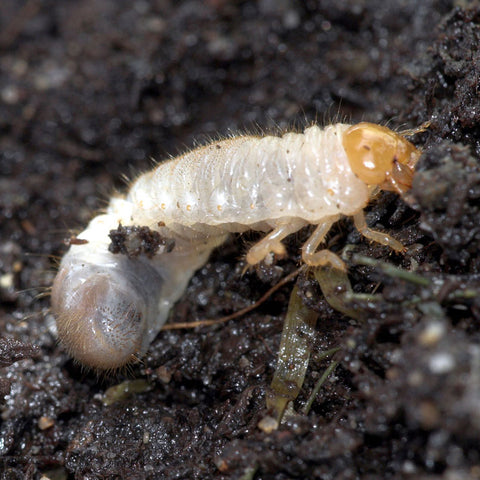
Symptoms
If the roots are being eaten by the larvae then you will most likely notice this by studying the leaves, which should begin to show signs of wilting. Evidence of the adult beetles attacks will be chewed leaves with notches in them, not the more rounded signs of snails, slugs or caterpillars. These chew marks will be sharper and in a sort of U-shape.
Treatment
Plant Care is apparently the only product on the market that is effective for an extended period of time against these pests. Something else which I can claim from personal experience only, so I am not certain, is that the larvae prefer growing mediums rich in organics. Since using soil-less growing mediums consisting mostly of Akadama, pumice or LECA I no longer encounter this pest so I can strongly suggest that changing to a different growing medium will largely address this problem or solve it altogether.
Thrips
Thrips are one of the more difficult pests to spot as they are tiny. Unfortunately the damage they inflict is not as difficult to spot. They feed in large groups and can leap into the air or fly if disturbed. Apparently they first damage the surface of the leaf and then proceed to suck the sap.

Symptoms
After thrips have attacked and sucked sap from a leaf one can easily see the silvery, semi-translucent trails which remain. Sometimes you might notice black or brown spots which are droppings.
Treatment
If using a chemical, contact type of spray it is best to apply the spray during the heat of the day as this is when thrips are more exposed as they explore their host tree. It is also very important to spray both the top and bottom surfaces of the leaves to break the cycle of infestation. I prefer to use systemic treatments which will prevent these pests from becoming a threat. Use Koinor to prevent and control thrips. Plant Care may be used for faster action and will act for up to 4 weeks.
Whitefly
If a branch infected with whitefly is disturbed you will see many small, white flies scatter. They are found in large groups, typically on the underside of leaves. These pests suck sap from the plant and are able to overwinter, so its another reason why winter spraying with lime sulphur is such a good preventative measure for not only whitefly but many other common pests. In my experience the trees most affected by whitefly is the olive and false olives.
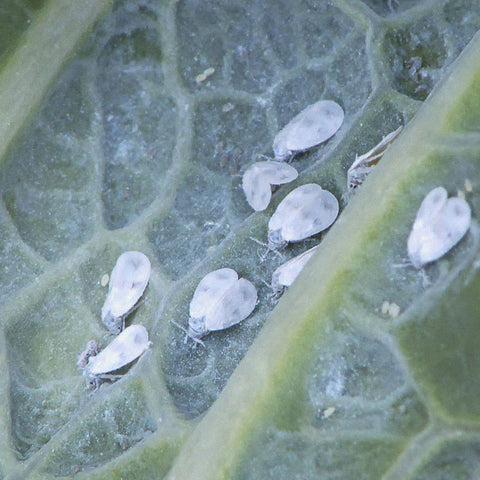
Symptoms
When whitefly suck the sap from the plant they secrete a sugary substance called "Honeydew." Honeydew in turn can lead to fungal diseases such as sooty black mould. Trees affected will be weakened. In bad infestations leaves may dry out and turn yellow, and growth of the tree will in turn be stunted. The easiest place to look for them is on the underside of leaves near to the leaf veins, where the most sap is. If the adults have flown off they may still leave some evidence behind in the form of their eggs which they also lay on the underside of the leaf.
Treatment
Since I was introduced to Koinor and began using it on my olives I have never again had problems with whitefly. However in order to use Koinor the tree must be growing very strongly in order for the roots to absorb the treatment before it is leached from the growing media. If you already have an infestation it might be best to spray with Plant Care as it will have an immediate effect and it is also systemic so will provide month long protection.






